Time Is on Your Side: The Gameplay of SUPERHOT
By gamer_152 3 Comments

SUPERHOT is the most innovative shooter I've played in years. The goal of action games (that is "action" used in the cinematic sense, not "action" meaning "hand-eye coordination") is to make us feel like the heroes of action films and novels. However, the protagonists of Hollywood blockbusters display superhuman reflexes and ingenuity that most us playing games could only dream of. For game designers, the solution is to give players various handicaps which allow the average person to go up against an army and remain standing. E.g. Being able to tolerate a magazine's worth of bullets to the chest without breaking a sweat or being able to carry around a virtual cargo container of loot while retaining the spring in our step. But in SUPERHOT there's no safety net for when we're shot; we die in a single hit. There's also no hammerspace inventory; we can only carry a single weapon at our side. The handicap we get instead is a tight grip on the passage of time: The slower we move, the slower time does, and the faster we move, the faster the rate at which it passes.
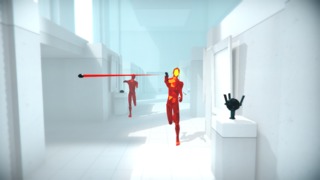
From here, we can begin to understand why SUPERHOT doesn't feel anything like other shooters: it forgoes the accepted methods of giving the player a helping hand and finds a whole new one. And despite how surreal and abstract this game is, in some ways, it's more realistic than your garden variety FPS. While other shooters depict you having borderline supernatural powers, if you speed up SUPERHOT's footage, just as the game does at the end of every level, you're not doing anything a real human being couldn't do. In its warping of the passage of time, SUPERHOT also reveals an uncanny relationship between time and gameplay. All games are reliant on the passing of time because actions, whether they're moving a ship across a board or bringing an axe down on a barbarian's head, take place over time. Games must react to our actions, and those reactions involve the game moving from one state to another; such state changes can only happen over time. However, some genres give game designers more choices in how they use time than others.
Games that test hand-eye coordination, including shooters, racing games, fighting games, and platformers, commonly ask us to either give corresponding responses to specific cues or to line up objects with other objects in 2D or 3D space. So beat-'em-ups often test our ability to get in punches and blocks within limited time windows, and racing games have us lining up cars with roads or driving lines. Any reaction time test must, by its nature, take place over time, and any alignment test must have a time limit on it because, with infinite time to perform it, there would be little challenge. The continual passage of time also gives games a brisk pacing, and these are both attributes we can see in SUPERHOT. It's a common misconception that time in SUPERHOT freezes when we stand still; it doesn't; it just moves very leisurely. With unlimited time to line up your shots with enemies, there'd be no tension, but as long as the bullets keep flying, you must line up reticles with bodies reasonably quickly, and can only stay static for so long.
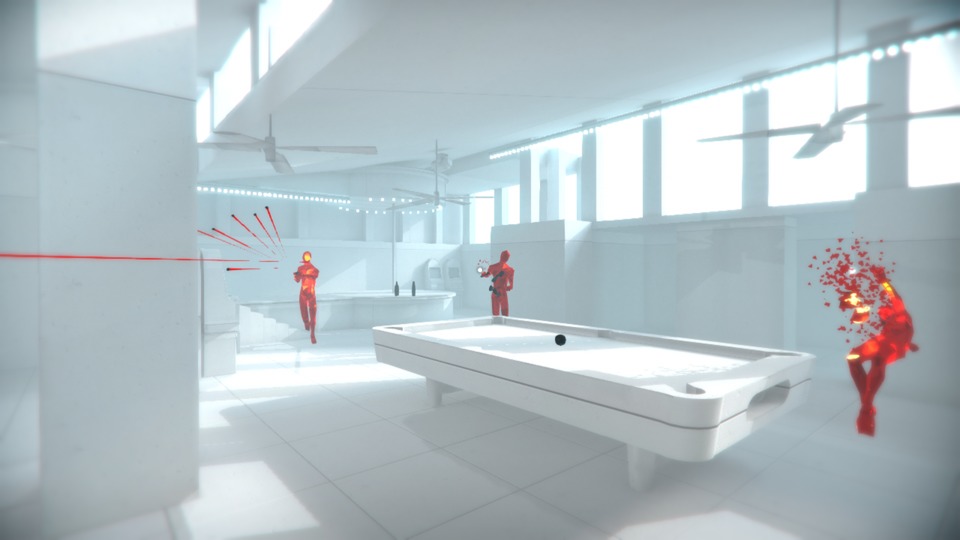
That's how time flows in hand-eye coordination games, but it's a little different for strategy games. Strategy titles ask us to think about variables, the positioning of units, or other aspects of the system and come to a conclusion about how to win, often in the most efficient manner. Even if they give us all the time in the world for this, it's usually an acute test of our cognitive abilities to work out what the optimal next move is, so there is challenge whether the designer makes the play turn-based or puts time pressures on us. For the developer, the choice between turn-based and real-time strategy is a choice about the rhythm of the game and whether they want to reward quick-thinking or the most painstakingly-considered moves. We may think of real-time strategy games as being played over passing time and turn-based strategy as not being played that way, but this isn't the case. The difference is more about when time moves and what happens during passing time. For example, turn-based strategy game Advance Wars has units stuck in place by default, effectively frozen in time, but when you command them to attack an enemy unit, the game shows them moving across the battlefield and then firing on the adversary over a period of time. There has to be a "before" and "after" for movement or attacks to be possible. So rather than Advance Wars being absent of time, it's more like time is frozen while you're making decisions and then unfreezes as those decisions are put into action.
You may have noticed that, based on these descriptions, SUPERHOT contains features of both hand-eye coordination and strategy games. It will give you a moment where you're considering the current positioning of your character relative to enemies and predicting where all the pieces will move next, a little like chess. Also similar to a strategy game, these moments of stillness have you planning the order you're going to dispatch the "Red Dudes" in and mentally mapping out your methods to do so. Because you die in one hit, stopping and thinking before you step forwards is a must. You even have to keep track of how many rounds are left in your gun, which means just like an action film protagonist, you know when "you're out". These tactical sections are interleaved with action sections where you're lining up reticles with bodies and dodging bullets. The frames of action are inherently moments in which time moves and the frames of strategy are those where time is pushed to the back burner. SUPERHOT's time-movement mechanic bakes varied pacing into the play; there are peaks in that pacing when game pieces move, then troughs when you're stationary and have some time to get a beat on your surroundings and think ahead.
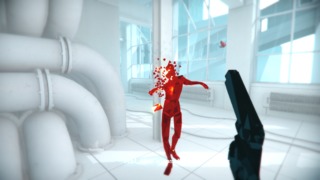
This is an experience that puts the impact back into strategy games. Hand-eye coordination games involve the direct manipulation of objects and so have an inherent "feel" to them. If gameplay is designed and programmed properly, the reward for success is not just points or progression, it's also getting to see an enemy recoil from a punch or feeling our vehicle thunder down a track. However, in strategy games, we rarely perform physical operations directly; we get units to carry them out for us, and so we miss out on that feel. Just now and then though, a game with an even balance of action and strategy like SUPERHOT will come along; one that rewards perceptiveness and foresight like a strategy game, but that gives us the physical satisfaction of feeling our finger on a trigger or our punches connect with flesh like a hand-eye coordination game.
In SUPERHOT, the feel of an action scene is highly palpable. It's present in the sound of the bullets whizzing past our head, the enemies procedurally slicing in two when we cut them with a katana, and the shattering of the Red Dudes when we kill them: an animation which helps signal their fragility. It also applies to picking up new weapons. A worthwhile task for any designer looking to improve a genre is to take the actions that feel purely functional to perform in other games and make them feel gratifying. Gears of War did this for reloading, Metroid did this for opening doors, and SUPERHOT does this for picking up weapons. Getting a new gun doesn't always mean walking over to it and pressing the "pick up" button; it more often means hitting someone with blunt force, watching their gun fly from their open palm, and then catching it in mid-air. The designers make sure you get plenty of chances to experience this by making the ammo on each of the weapons so low that you'll need to obtain new ones regularly.
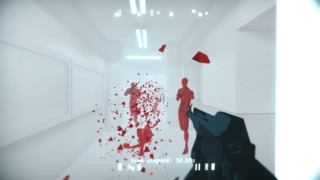
While I'm happy to extol the benefits of SUPERHOT splaying itself across the dividing line between strategy and action, its hybrid nature does, however, mean that it feels neither like a fully-matured action game nor an expansive tactical game. It can't keep up the swift pacing of the most spell-binding shooters, and there's not a lot of hidden depth in or learning you can do when approaching the game's systems. You can pick any two SUPERHOT levels and won't find humongous differences in how they play, and the game doesn't break up its combat with environmental exploration, character management, or many of the other methods which other titles use to prevent homogenous stretches of play. One of SUPERHOT's greatest strengths is that the gameplay you see when you first boot it up is an accurate representation of the whole experience, but that initial snapshot of play represents almost all you get for the rest of the campaign. This doesn't necessarily constitute anything wrong with SUPERHOT, but it's probably a factor in the story mode only being two hours long, and it's why even those two hours I chewed through in three separate sessions.
To be fair, SUPERHOT does the right thing by rolling its credits around the 120-minute mark; it's not one of these games that takes the popular stance that you need to pad a title out to several hours because that's the way we make video games. And while the game may not have much hidden depth, it does have hidden variety, perhaps too hidden. Once you complete that campaign, you can jack back into it with a whole host of modifiers like "Katana Only" or time limits on levels. It revitalises the play and makes it so that when you get bored, you can turn on a different modifier and experience an immediate change in how you have to think about approaching its conundrums. SUPERHOT isn't telling you how long the experience should be, but by giving you a short story mode and then a bevvy of new ways to play after completing the story mode, is asking you the appropriate length for it, and that flexibility in length means many more players can leave with a smile on their face.
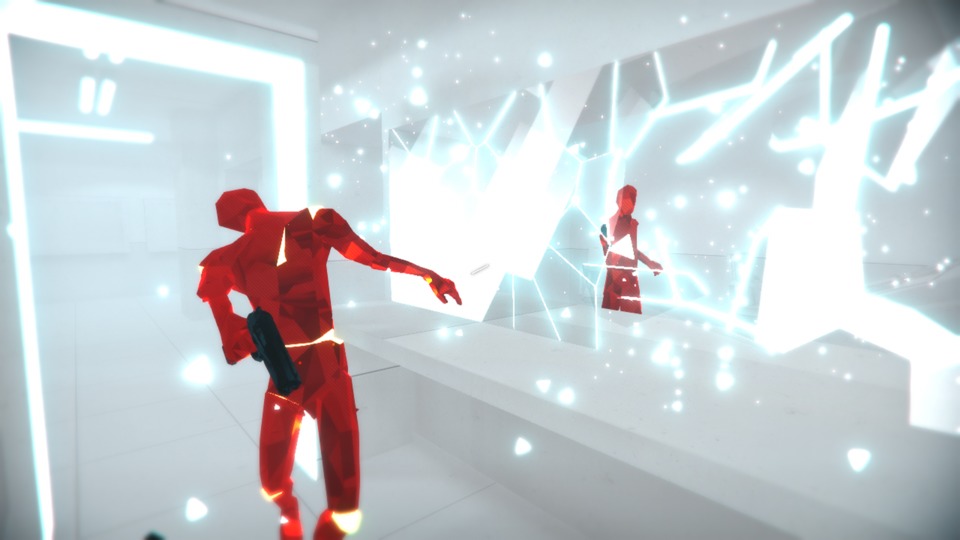
For me, there are only two details in SUPERHOT's design that stick out as unjustifiable. The first is that with enemies spawning from all directions and you having one point of health, you often need to spin around after every kill or two to check that there aren't bullets sailing towards you sight unseen. It's methodical and does not enhance gameplay. One of the reasons that most other shooters offer us the handicap of a pool of health is because they know that we can't always see where we're going to get shot from next and don't that we don't have full body awareness. This is also why many stealth games have minimaps and other forms of perception that let us see enemies outside of our direct line of sight, but SUPERHOT has no such aid. The second issue is that, even when you clock the shot flying towards you, a bullet that appears to be travelling slightly to the left or slightly to the right of the camera can still kill you. Perhaps this happens because your character model's head is wider than the viewport lets on or maybe it's because rounds can strike you in the shoulders, but it gives me a twinge of frustration every time I move out of the path of a bullet and get punished anyway. But even when I get annoyed with SUPERHOT, it's only because I want to connect with what is otherwise a bewitching and mind-bending play experience.
In SUPERHOT, I see a lot of the spirit of the early 00s: It's a shooter suspended in eternal bullet time and the slowing-down of the fight sequences lets you appreciate and take stock of every little gunshot and punch. In fact, with its slow-motion scenes, its cocktail of hand-to-hand combat and gunplay, its identical villains, its faceless urban locations, its simulated world, and its hacker iconography, SUPERHOT feels like The Matrix FPS we never got. Put on Clubbed to Death, drop into the parking garage level, and you feel like Neo. Part of SUPERHOT's innovation comes from it chaining its play speed to its movement speed, but you know what else is superbly "innovative" about this game? It's a first-person shooter that, on the whole, has a slow pace rather than a fast pace. SUPERHOT changes the fundamentals of the shooter format to the extent that it's hard to imagine it being an influence on the genre. It's so far divorced from how shooters typically play that if other FPSs were to adopt the mechanics of SUPERHOT, they wouldn't be FPSs as we know them, they'd become a whole new family of games. But that's okay; that's a testament to the originality and even the beautiful weirdness of SUPERHOT. Thanks for reading.